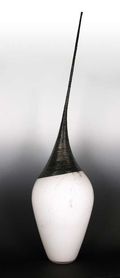04 Feb Pflipsen-Olivova at Telluride’s Lustre Gallery for Art Walk,2/4
[click “Play” to hear Susan’s conversation with Katia and Steve]
 Sponsored by the Telluride Council for the Arts and Humanities, First Thursday Art Walk has become what to do apres ski or pre-prandial for Telluride locals and guests, who get to soak in the town’s fine art and retail scene: galleries, studios, arts organizations (such as the Council) and retail stores located in and around Colorado Avenue (Main Street) stay open late until 8 p.m. Lustre Artisans Gallery is one of the participating venues.
Sponsored by the Telluride Council for the Arts and Humanities, First Thursday Art Walk has become what to do apres ski or pre-prandial for Telluride locals and guests, who get to soak in the town’s fine art and retail scene: galleries, studios, arts organizations (such as the Council) and retail stores located in and around Colorado Avenue (Main Street) stay open late until 8 p.m. Lustre Artisans Gallery is one of the participating venues.
For Art Walk, February 4 (also Friday, February 5), 4 – 7 p.m., the husband and wife team of Steve Pflipsen and Katia Pflipsen-Olivová are on hand at Lustre for an artists’ reception. The couple will be talking about their newest large-scale sculptural glass vessels.( Also at Lustre, a trunk show featuring 24K gold jewelry by Gurham, who fashions his contemporary pieces based on techniques dating back thousands of years.)
 Glass blowing started 5,000 years ago in Western Asia. Until the 1960s, when glass moved from a factory to a studio setting, glass objects were either useful or decorative. There was the plain vanilla glass we look through and took for granted – light bulbs, TV screens, mirrors, windows, servers and preservers of food. And there was glass, though functional, we looked at and admired: form meets function in the decorative objects for table and desk top by Baccarat, Waterford, Lalique, Daum, Tiffany, and Steuben. Finally there was glass made purely for art’s sake by studio artists such as Dale Chihuly and William Morris. For years, curators and critics agreed to disagree about fine art glass: was it art or was it craft? If art, objects belonged in museums – and dealers could charge more. Bingo. In the 1980s, the debate was settled and glass art became a favorite of collectors and museums, setting the stage for Pflipsen-Olivova Studio in River Falls, Wisconsin.
Glass blowing started 5,000 years ago in Western Asia. Until the 1960s, when glass moved from a factory to a studio setting, glass objects were either useful or decorative. There was the plain vanilla glass we look through and took for granted – light bulbs, TV screens, mirrors, windows, servers and preservers of food. And there was glass, though functional, we looked at and admired: form meets function in the decorative objects for table and desk top by Baccarat, Waterford, Lalique, Daum, Tiffany, and Steuben. Finally there was glass made purely for art’s sake by studio artists such as Dale Chihuly and William Morris. For years, curators and critics agreed to disagree about fine art glass: was it art or was it craft? If art, objects belonged in museums – and dealers could charge more. Bingo. In the 1980s, the debate was settled and glass art became a favorite of collectors and museums, setting the stage for Pflipsen-Olivova Studio in River Falls, Wisconsin.
Katerina (Katia) was literally born to her art, the offspring of family of successful glass artists in Northern Bohemia in the Czech Republic, where art glass – or glass art – is the indigenous crop. Steve and Katia met while studying at a glassmaking school in Kamenický Šenov, in the Czech Republic. Love for each other and their art form soldered the relationship. Pflipsen Glassworks mixed media sculptures vases and jewelry are as unique as the couple who create them.
To learn more about their life and work, click the “play” button and listen to Katia and Steve’s podcast.


Sorry, the comment form is closed at this time.